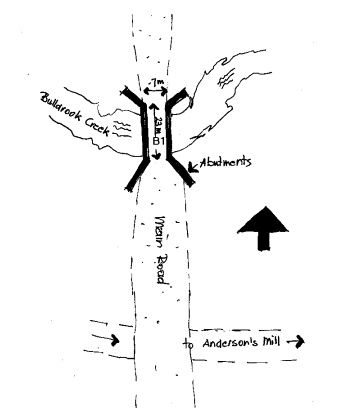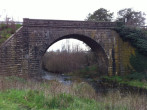BRIDGE
OVER BIRCH (FORMERLY BULLAROOK) CREEK, NEWSTEAD-CRESWICK ROAD SMEATON, HEPBURN SHIRE
-
Add to tour
You must log in to do that.
-
Share
-
Shortlist place
You must log in to do that.
- Download report




Statement of Significance
What is significant?
The Bridge over Birch (formerly Bullarook) Creek on the Ballarat to Castlemaine Road is a notable example of a small bluestone bridge. The single span, 50 foot bridge was constructed in 1892 for the Creswick Shire and it was designed by engineers H and W H Gore; William Barker was the successful contractor. The bridge has unusually wide spreading abutments in proportion to its span.
How is it significant?
The Bridge over Birch (formerly Bullarook) Creek is of architectural and historical significance to the State of Victoria.
How is it significant?
The Bridge over Birch (formerly Bullarook) Creek is architecturally significant as an intact representative example of a small, late Victorian stone bridge. The bridge is an excellent example of stonemason's art and is aesthetically pleasing with its ornately carved stone commemorative plaques, rusticated string courses, parapet cappings, voussoirs and a small gargoyle to the southwest face of the bridge. The structure is typical of a vernacular engineering tradition but is distinguished by the high quality of its craftsmanship.
The Bridge over Birch (formerly Bullarook) Creek is historically significant for its association with the Anderson brothers and the Georgian inspired Anderson's Mill (currently registered GBR477). There are two bridges in close proximity to the Mill (the bluestone bridge over Bullarook Creek and the current mill bridge); however the Bullarook Creek Bridge was at one stage referred to as the 'Smeaton Mill Bridge' by the Public Works Department. Whilst somewhat confusing, this reference assists in explaining the massive piers and abutments which form part of the Bullarook Creek bridge, most likely constructed specifically to support the heavily-laden drays and wagons transporting materials to Anderson's Mill. The solidity of both the Bullarook Creek Bridge and the mill bridge may also have been a reaction to the disastrous consequences of a succession of floods which swept through the area in the 1870s.
The Birch (formerly Bullarook) CreekBridge is of historical significance for its ability to describe transport routes and requirements of the 1890s and in particular for its close relationship with the significant Anderson's Mill.
-
-
BRIDGE - History
Contextual History:History of Place:
The need for infrastructure in a rapidly expanding settlement necessitated the construction of Australia's first roads shortly after the arrival of the first settlers. A first roadmap for Victoria dates from 1837. In 1838, the New South Wales Government authorised a survey of a road from Sydney to Melbourne and a contract was let for a fortnightly mail journey between the two centres.
This route passed through Kilmore to Seymour and then along the present Hume Highway to Albury.
Due to the gold rushes of the 1850's there was rapid growth in economic activity in Australia. Investment in roads and railways helped establish the national transport system and bridges formed important links in this expanding network.
The earliest Victorian bridges are not easy to trace, as they were apparently minor (often timber) structures on rural or makeshift roads.
Many bridges were opened at the time of the major railways in the 1860's and the expanding roadworks around Melbourne.
There are several other examples of masonry (bluestone bridges) in the area. The present bridge at Bulla over Deep Creek (higher section of the Maribyrnong River) has four 8.2 spans and dates from around 1869. The bluestone bridge at Sunbury has two 13.4 meter arch spans and dates from 1870.
History of Place:
The bridge was built in 1892 over Bullarook Creek for the Creswick shire Council.
A commemorative plaque lists all the local notoriety's who were present at the opening of the bridge. John Parkin, the Shire president in the company of John Anderson, John Leishman, Mr Graves and C.L. Nase. The Councillors Th. Fletcher, Alex Clarke, T.C. Naples and David Mc Grath were present also.
John Anderson, one of the Anderson brothers, was closely involved with Creswick Shire municipal politics for many years.
Henry Gore and W.H. Gore, Engineers designed the bridge. William Barker was the successful contractor and Simon Jory the supervising Clerk of Works.
The bridge over Bullarook Creek is also significant because its association with and proximity to Anderson's Mill. One of the owners, John Anderson, attended the opening of the Mill.
There are two bridges near Anderson's Mill; the bluestone main road bridge and the current mill bridge. The mill bridge serves as an entrance to Anderson's Mill. Anderson's Mill has been in operation since 1862. The Mill was built for the Anderson family who were millers and timber cutters.
Descendants of the Anderson family remember that the mill bridge replaced an earlier timber bridge. Severe floods have been recorded in October 1870 and early in February 1871.
Matters are somewhat confusing as the main road bridge was also known as 'the Smeaton Mill bridge' to Melbourne Public Works authorities. Considering the Mill was in operation by 1862, it is quite plausible that the main road bridge was also preceded by a timber bridge.
The massive nature of the abutments and piers may be partially explained by the needs dictated by the traffic to the Mill which would have mainly consisted of heavily-laden bullock drays and wagons transporting raw materials to the Mill. The solidity of both the main road bridge and the mill bridge may also have been a reaction to the disastrous consequences of a succession of floods.
COMPARISON:
The bridge over Bullarook Creek is essentially a typical late Victorian Stone bridge. There are several earlier examples of the masonry bridges from the same period in Melbourne and regional Victoria. Although some of them have been altered to cater for the rise of motor vehicular traffic, most of them are in good condition. There is variety in shape, size and character.
The bridge offers additional interest because of the commemorative plaque, the two styles of rusticated stone surfaces. Compared to other blue stone bridges, it is relatively small.
By that time, the introduction and experimentation with new materials such as concrete and steel in bridge design had already started.
Other bluestone bridges
Other earlier bridges in the same tradition such as the Newlands Road Bridge in Coburg has three 9.1 meter spans and was built by prisoners from the Pentridge Gaol. At Waurn Ponds, a small stone bridge carries a crest and the inscription "Barrabool Shire. 1868". Corkscrew bridge (over the Kororoit Creek on a disused section of the Calder highway near Melton) is an early single span bluestone bridge dating from 1862.
The Mill is an excellent example of Georgian derived Colonial industrial design.BRIDGE - Permit Exemptions
General Exemptions:General exemptions apply to all places and objects included in the Victorian Heritage Register (VHR). General exemptions have been designed to allow everyday activities, maintenance and changes to your property, which don’t harm its cultural heritage significance, to proceed without the need to obtain approvals under the Heritage Act 2017.Places of worship: In some circumstances, you can alter a place of worship to accommodate religious practices without a permit, but you must notify the Executive Director of Heritage Victoria before you start the works or activities at least 20 business days before the works or activities are to commence.Subdivision/consolidation: Permit exemptions exist for some subdivisions and consolidations. If the subdivision or consolidation is in accordance with a planning permit granted under Part 4 of the Planning and Environment Act 1987 and the application for the planning permit was referred to the Executive Director of Heritage Victoria as a determining referral authority, a permit is not required.Specific exemptions may also apply to your registered place or object. If applicable, these are listed below. Specific exemptions are tailored to the conservation and management needs of an individual registered place or object and set out works and activities that are exempt from the requirements of a permit. Specific exemptions prevail if they conflict with general exemptions. Find out more about heritage permit exemptions here.Specific Exemptions:EXEMPTIONS FROM PERMITS:
(Classes of works or activities which may be undertaken without a permit under
Part 4 of the Heritage Act 1995)
General Conditions:
All alterations are to be planned and carried out in a manner which prevents
damage to the fabric of the registered place or object.
Should it become apparent during further inspection or the carrying out of
alterations that original or previously hidden or inaccessible details of the
place or object are revealed which relate to the significance of the place or
object, then the exemption covering such alteration shall cease and the
Executive Director shall be notified as soon as possible.
If there is a conservation policy and plan approved by the Executive Director,
all works shall be in accordance with it.
Nothing in this declaration prevents the Executive Director from amending or
rescinding all or any of the permit exemptions.
Nothing in this declaration exempts owners or their agents from the
responsibility to seek relevant planning or building permits from the
responsible authority where applicable.
No permit required for routine maintenance of the Bridge over Bullarook Creek
No permit required to replace like with like on the Bridge over Bullarook
Creek.
-
-
-
-
-
ANDERSONS MILL COMPLEX
 Victorian Heritage Register H1521
Victorian Heritage Register H1521 -
ANDERSONS MILL
 Victorian Heritage Inventory
Victorian Heritage Inventory -
SMEATON RESERVE MINE
 Victorian Heritage Inventory
Victorian Heritage Inventory
-
"1890"
 Yarra City
Yarra City -
'BRAESIDE'
 Boroondara City
Boroondara City -
'ELAINE'
 Boroondara City
Boroondara City
-
-
Images See all images











